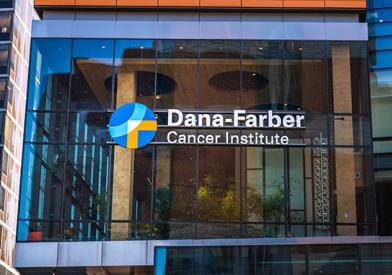-
p16INK4A-deficiency predicts response to combined HER2 and CDK4/6 inhibition in HER2+ breast cancer brain metastases. Nat Commun. 2022 03 18; 13(1):1473. View in:
Pubmed
-
FOXA1 upregulation promotes enhancer and transcriptional reprogramming in endocrine-resistant breast cancer. Proc Natl Acad Sci U S A. 2019 Dec 26; 116(52):26823-26834. View in:
Pubmed
-
Signatures of T cell dysfunction and exclusion predict cancer immunotherapy response. Nat Med. 2018 10; 24(10):1550-1558. View in:
Pubmed
-
Enhancing Therapy: It's about Time. Cell. 2018 08 09; 174(4):771-772. View in:
Pubmed
-
Genome-wide CRISPR screen identifies HNRNPL as a prostate cancer dependency regulating RNA splicing. Proc Natl Acad Sci U S A. 2017 06 27; 114(26):E5207-E5215. View in:
Pubmed
-
Embryonic transcription factor SOX9 drives breast cancer endocrine resistance. Proc Natl Acad Sci U S A. 2017 05 30; 114(22):E4482-E4491. View in:
Pubmed
-
TransCONFIRM: Identification of a Genetic Signature of Response to Fulvestrant in Advanced Hormone Receptor-Positive Breast Cancer. Clin Cancer Res. 2016 Dec 01; 22(23):5755-5764. View in:
Pubmed
-
SLCO2B1 and SLCO1B3 may determine time to progression for patients receiving androgen deprivation therapy for prostate cancer. J Clin Oncol. 2011 Jun 20; 29(18):2565-73. View in:
Pubmed
-
BINOCh: binding inference from nucleosome occupancy changes. Bioinformatics. 2011 Jul 01; 27(13):1867-8. View in:
Pubmed
-
PKA-dependent regulation of the histone lysine demethylase complex PHF2-ARID5B. Nat Cell Biol. 2011 Jun; 13(6):668-75. View in:
Pubmed
-
ß-Catenin is a useful adjunct immunohistochemical marker for the diagnosis of pulmonary lymphangioleiomyomatosis. Am J Clin Pathol. 2011 May; 135(5):776-82. View in:
Pubmed
-
Epigenetic switch involved in activation of pioneer factor FOXA1-dependent enhancers. Genome Res. 2011 Apr; 21(4):555-65. View in:
Pubmed
-
CaM kinase kinase beta-mediated activation of the growth regulatory kinase AMPK is required for androgen-dependent migration of prostate cancer cells. Cancer Res. 2011 Jan 15; 71(2):528-37. View in:
Pubmed
-
Differentiation-specific histone modifications reveal dynamic chromatin interactions and partners for the intestinal transcription factor CDX2. Dev Cell. 2010 Nov 16; 19(5):713-26. View in:
Pubmed
-
Genomic collaboration of estrogen receptor alpha and extracellular signal-regulated kinase 2 in regulating gene and proliferation programs. Mol Cell Biol. 2011 Jan; 31(1):226-36. View in:
Pubmed
-
Growth factor stimulation induces a distinct ER(alpha) cistrome underlying breast cancer endocrine resistance. Genes Dev. 2010 Oct 01; 24(19):2219-27. View in:
Pubmed
-
TCF4 and CDX2, major transcription factors for intestinal function, converge on the same cis-regulatory regions. Proc Natl Acad Sci U S A. 2010 Aug 24; 107(34):15157-62. View in:
Pubmed
-
8q24 prostate, breast, and colon cancer risk loci show tissue-specific long-range interaction with MYC. Proc Natl Acad Sci U S A. 2010 May 25; 107(21):9742-6. View in:
Pubmed
-
Estrogen-dependent and estrogen-independent mechanisms contribute to AIB1-mediated tumor formation. Cancer Res. 2010 May 15; 70(10):4102-11. View in:
Pubmed
-
Subcellular localization of activated AKT in estrogen receptor- and progesterone receptor-expressing breast cancers: potential clinical implications. Am J Pathol. 2010 May; 176(5):2139-49. View in:
Pubmed
-
Nucleosome dynamics define transcriptional enhancers. Nat Genet. 2010 Apr; 42(4):343-7. View in:
Pubmed
-
MYC regulation of a "poor-prognosis" metastatic cancer cell state. Proc Natl Acad Sci U S A. 2010 Feb 23; 107(8):3698-703. View in:
Pubmed
-
Multimodal regulation of E2F1 gene expression by progestins. Mol Cell Biol. 2010 Apr; 30(8):1866-77. View in:
Pubmed
-
Control of cyclin D1 and breast tumorigenesis by the EglN2 prolyl hydroxylase. Cancer Cell. 2009 Nov 06; 16(5):413-24. View in:
Pubmed
-
Elucidation of the ELK1 target gene network reveals a role in the coordinate regulation of core components of the gene regulation machinery. Genome Res. 2009 Nov; 19(11):1963-73. View in:
Pubmed
-
Androgen receptor regulates a distinct transcription program in androgen-independent prostate cancer. Cell. 2009 Jul 23; 138(2):245-56. View in:
Pubmed
-
Estradiol-regulated microRNAs control estradiol response in breast cancer cells. Nucleic Acids Res. 2009 Aug; 37(14):4850-61. View in:
Pubmed
-
FOXA1 is a potential oncogene in anaplastic thyroid carcinoma. Clin Cancer Res. 2009 Jun 01; 15(11):3680-9. View in:
Pubmed
-
Induction of Kruppel-like factor 5 expression by androgens results in increased CXCR4-dependent migration of prostate cancer cells in vitro. Mol Endocrinol. 2009 Sep; 23(9):1385-96. View in:
Pubmed
-
Cistromics of hormone-dependent cancer. Endocr Relat Cancer. 2009 Jun; 16(2):381-9. View in:
Pubmed
-
Coactivator function defines the active estrogen receptor alpha cistrome. Mol Cell Biol. 2009 Jun; 29(12):3413-23. View in:
Pubmed
-
The role of microRNA-221 and microRNA-222 in androgen-independent prostate cancer cell lines. Cancer Res. 2009 Apr 15; 69(8):3356-63. View in:
Pubmed
-
Genome-wide impact of androgen receptor trapped clone-27 loss on androgen-regulated transcription in prostate cancer cells. Cancer Res. 2009 Apr 01; 69(7):3140-7. View in:
Pubmed
-
Integrative analysis of HIF binding and transactivation reveals its role in maintaining histone methylation homeostasis. Proc Natl Acad Sci U S A. 2009 Mar 17; 106(11):4260-5. View in:
Pubmed
-
Cell-type selective chromatin remodeling defines the active subset of FOXA1-bound enhancers. Genome Res. 2009 Mar; 19(3):372-80. View in:
Pubmed
-
Combining chromatin immunoprecipitation and oligonucleotide tiling arrays (ChIP-Chip) for functional genomic studies. Methods Mol Biol. 2009; 556:155-64. View in:
Pubmed
-
Regulation of ERBB2 by oestrogen receptor-PAX2 determines response to tamoxifen. Nature. 2008 Dec 04; 456(7222):663-6. View in:
Pubmed
-
AKT alters genome-wide estrogen receptor alpha binding and impacts estrogen signaling in breast cancer. Mol Cell Biol. 2008 Dec; 28(24):7487-503. View in:
Pubmed
-
Unique ERalpha cistromes control cell type-specific gene regulation. Mol Endocrinol. 2008 Nov; 22(11):2393-406. View in:
Pubmed
-
Model-based analysis of ChIP-Seq (MACS). Genome Biol. 2008; 9(9):R137. View in:
Pubmed
-
Androgen receptor mediates the expression of UDP-glucuronosyltransferase 2 B15 and B17 genes. Prostate. 2008 Jun 01; 68(8):839-48. View in:
Pubmed
-
Estrogen-dependent signaling in a molecularly distinct subclass of aggressive prostate cancer. J Natl Cancer Inst. 2008 Jun 04; 100(11):815-25. View in:
Pubmed
-
CD151 accelerates breast cancer by regulating alpha 6 integrin function, signaling, and molecular organization. Cancer Res. 2008 May 01; 68(9):3204-13. View in:
Pubmed
-
FoxA1 translates epigenetic signatures into enhancer-driven lineage-specific transcription. Cell. 2008 Mar 21; 132(6):958-70. View in:
Pubmed
-
Targeting NF-kappaB in Waldenstrom macroglobulinemia. Blood. 2008 May 15; 111(10):5068-77. View in:
Pubmed
-
Unraveling estrogen action in osteoporosis. Cell Cycle. 2008 May 15; 7(10):1348-52. View in:
Pubmed
-
Estrogen protects bone by inducing Fas ligand in osteoblasts to regulate osteoclast survival. EMBO J. 2008 Feb 06; 27(3):535-45. View in:
Pubmed
-
xMAN: extreme MApping of OligoNucleotides. BMC Genomics. 2008; 9 Suppl 1:S20. View in:
Pubmed
-
CARM1 regulates estrogen-stimulated breast cancer growth through up-regulation of E2F1. Cancer Res. 2008 Jan 01; 68(1):301-6. View in:
Pubmed
-
A hierarchical network of transcription factors governs androgen receptor-dependent prostate cancer growth. Mol Cell. 2007 Aug 03; 27(3):380-92. View in:
Pubmed
-
Positive cross-regulatory loop ties GATA-3 to estrogen receptor alpha expression in breast cancer. Cancer Res. 2007 Jul 01; 67(13):6477-83. View in:
Pubmed
-
Targeting the AIB1 oncogene through mammalian target of rapamycin inhibition in the mammary gland. Cancer Res. 2006 Dec 01; 66(23):11381-8. View in:
Pubmed
-
Genome-wide analysis of estrogen receptor binding sites. Nat Genet. 2006 Nov; 38(11):1289-97. View in:
Pubmed
-
A cell-type-specific transcriptional network required for estrogen regulation of cyclin D1 and cell cycle progression in breast cancer. Genes Dev. 2006 Sep 15; 20(18):2513-26. View in:
Pubmed
-
Model-based analysis of tiling-arrays for ChIP-chip. Proc Natl Acad Sci U S A. 2006 Aug 15; 103(33):12457-62. View in:
Pubmed
-
p63 regulates an adhesion programme and cell survival in epithelial cells. Nat Cell Biol. 2006 Jun; 8(6):551-61. View in:
Pubmed
-
X chromosomal abnormalities in basal-like human breast cancer. Cancer Cell. 2006 Feb; 9(2):121-32. View in:
Pubmed
-
Proceedings of the Fifth International Conference on Recent Advances and Future Directions in Endocrine Therapy for Breast Cancer: conference summary statement. Clin Cancer Res. 2006 Feb 01; 12(3 Pt 2):997s-1000s. View in:
Pubmed
-
Estrogen receptor target gene: an evolving concept. Mol Endocrinol. 2006 Aug; 20(8):1707-14. View in:
Pubmed
-
Spatial and temporal recruitment of androgen receptor and its coactivators involves chromosomal looping and polymerase tracking. Mol Cell. 2005 Sep 02; 19(5):631-42. View in:
Pubmed
-
Chromosome-wide mapping of estrogen receptor binding reveals long-range regulation requiring the forkhead protein FoxA1. Cell. 2005 Jul 15; 122(1):33-43. View in:
Pubmed
-
Androgen mediated regulation and functional implications of fkbp51 expression in prostate cancer. J Urol. 2005 May; 173(5):1772-7. View in:
Pubmed
-
Cell cycle progression stimulated by tamoxifen-bound estrogen receptor-alpha and promoter-specific effects in breast cancer cells deficient in N-CoR and SMRT. Mol Endocrinol. 2005 Jun; 19(6):1543-54. View in:
Pubmed
-
High tumor incidence and activation of the PI3K/AKT pathway in transgenic mice define AIB1 as an oncogene. Cancer Cell. 2004 Sep; 6(3):263-74. View in:
Pubmed
-
Coactivator AIB1 links estrogen receptor transcriptional activity and stability. Proc Natl Acad Sci U S A. 2004 Aug 10; 101(32):11599-604. View in:
Pubmed
-
Proceedings of the Third International Conference on Recent Advances and Future Directions in Endocrine Manipulation of Breast Cancer: conference summary statement. Clin Cancer Res. 2004 Jan 01; 10(1 Pt 2):327S-330S. View in:
Pubmed
-
Advances in estrogen receptor biology: prospects for improvements in targeted breast cancer therapy. Breast Cancer Res. 2004; 6(1):39-52. View in:
Pubmed
-
Agonist and chemopreventative ligands induce differential transcriptional cofactor recruitment by aryl hydrocarbon receptor. Mol Cell Biol. 2003 Nov; 23(21):7920-5. View in:
Pubmed
-
Coregulator expression and breast cancer: improving the predictive power of estrogen receptor alpha. Clin Cancer Res. 2003 Apr; 9(4):1229-30. View in:
Pubmed
-
Overview consensus statement. Newer approaches to androgen deprivation therapy in prostate cancer. Urology. 2002 Sep; 60(3 Suppl 1):1-6. View in:
Pubmed
-
ERAP140, a conserved tissue-specific nuclear receptor coactivator. Mol Cell Biol. 2002 May; 22(10):3358-72. View in:
Pubmed
-
Molecular determinants for the tissue specificity of SERMs. Science. 2002 Mar 29; 295(5564):2465-8. View in:
Pubmed
-
Formation of the androgen receptor transcription complex. Mol Cell. 2002 Mar; 9(3):601-10. View in:
Pubmed
-
The androgen receptor CAG repeat polymorphism and risk of breast cancer in the Nurses' Health Study. Cancer Res. 2002 Feb 15; 62(4):1045-9. View in:
Pubmed
-
No association between a single nucleotide polymorphism in CYP19 and breast cancer risk. Cancer Epidemiol Biomarkers Prev. 2002 Feb; 11(2):215-6. View in:
Pubmed
-
Growth factor requirements and basal phenotype of an immortalized mammary epithelial cell line. Cancer Res. 2002 Jan 01; 62(1):89-98. View in:
Pubmed









